Lessico
Natrice
Biscia dal collare - Biscia d'acqua
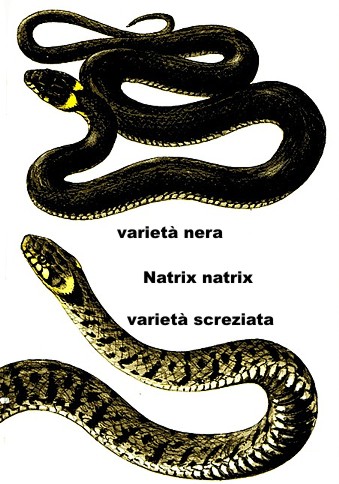
Natrix
natrix e biló
La biscia d'acqua dal collare
e il pene di Valenza (AL) ![]()
Natrice deriva dal latino natrix -icis, nuotatrice. Il verbo latino no, io nuoto, è stato progressivamente sostituito da nato. In greco abbiamo néø da cui deriva nëchø: ambedue significano io nuoto.
Natrix è un sostantivo latino per lo più femminile che deriva da natum, un supino di no mai utilizzato in letteratura, e ha come primo significato quello di biscia d'acqua, biscia che nuota. Per antonomasia questa biscia è la Natrix natrix, della famiglia Colubridi, detta anche biscia dal collare. Comune in tutta Europa, nuota nelle raccolte d'acqua dolce di ogni tipo con un rapido e sinuoso movimento, mantenendo la testa leggermente sollevata dalla superficie; è altresì in grado di rimanere a lungo immersa in prossimità del fondo. Tuttavia la natrice trascorre la maggior parte del tempo sulla terraferma. Si ciba di pesciolini e rane ed è del tutto inoffensiva per l'uomo, malgrado la sua saliva sia tossica per alcuni piccoli animali. La lunghezza totale è di 1 metro nei maschi, nelle femmine di alcune sottospecie può raggiungere i 2 metri.
Ma il
latino natrix ha anche un senso traslato. Il poeta satirico Gaio
Lucilio![]() (ca. 180
- ca. 102 aC) usò natrix col significato di membro virile o pene che
dir si voglia:
(ca. 180
- ca. 102 aC) usò natrix col significato di membro virile o pene che
dir si voglia:
Si
natibus natricem impressit crassam et capitatam
Se conficcò nelle natiche una natrice grossa e dalla grande testa.
Non è difficile capire perché Lucilio abbia adottato natrix - una biscia, che è una serpe non velenosa - per esprimere il pene. Noi lo chiamiamo più volentieri uccello, in quanto andando in erezione vola in alto. Ercole Scerbo in Il nome della cosa (1991) così afferma:
La genesi
delle metafore, degli eufemismi e dei nomignoli relativi agli organi sessuali
è quasi sempre connessa con una delle seguenti motivazioni:
a) la forma e le caratteristiche di alcuni oggetti (bastone, manico, verga,
candela, pistola e simili per il genitale maschile; vaso, astuccio, tegame e simili per quello femminile);
b) la forma e le caratteristiche di alcuni animali (biscia, anguilla, uccello,
pesce eccetera per il sesso maschile; passera,
piccione eccetera per quello femminile);
E aggiunge:
Nell’area italiana,
specialmente in Toscana, si registra il nome allusivo biscia (dal latino tardo
bistia). Giambattista Casti ci ha lasciato, fra l’altro, i seguenti
versi:
Slaccia la veste, e perché la camiscia
fatta è da mano avara, esce la biscia.
Altro nome allusivo del pene è “serpente”, dal latino serpens, participio presente del verbo serpere, “insinuarsi”, “penetrare”. Ricordiamo che il
serpente presso i Gond dell’India stava alla base dei culto fallico. Fra le
poesie di stampo goliardico leggiamo:
Nessun dal capo mi leva
che il frutto proibito fosse la fica di Eva
e che il serpente disceso dal ramo
non fosse null’altro che il cazzo d’Adamo.
Emmanuelle Arsan in un suo romanzo erotico scrisse che la ragazza «aiutava
come meglio poteva il favoloso serpente a strisciare nell’intimo del suo
corpo».
I Gond sono una minoranza etnica indiana che abita principalmente la zona del Madhya Pradesh. Sono discendenti delle antiche popolazioni dravidiche e nonostante le inevitabili influenze di etnie indiane hanno mantenuto quasi intatte le caratteristiche originali. Mantengono la divisione in fratrie e in clan totemici. Pur essendo in parte diventati agricoltori, la caccia e la raccolta tradizionali hanno ancora notevole importanza.
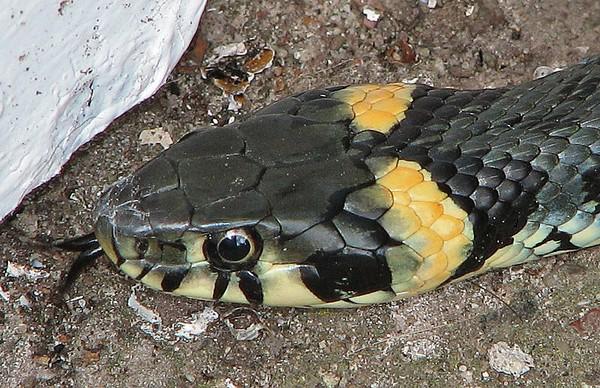
Riprendiamo e ripetiamo alcune caratteristiche della biscia dal collare. La Natrix natrix (Linnaeus, 1758) presenta una colorazione prevalentemente grigio-verdastra, con macchiettatura nera; al limite tra il collo e il capo spiccano due macchie bianco-giallastre, costituenti una sorta di collare. Comune in tutta Europa, nuota nelle raccolte d'acqua dolce di ogni tipo con un rapido e sinuoso movimento, mantenendo la testa leggermente sollevata dalla superficie; è altresì in grado di rimanere a lungo immersa in prossimità del fondo. Tuttavia, la natrice. trascorre la maggior parte del tempo sulla terraferma. Si ciba di pesciolini e rane ed è del tutto inoffensiva per l'uomo, malgrado la sua saliva sia tossica per alcuni piccoli animali. Specie affini sono la natrice tessellata (Natrix tessellata), essendo il tessellato un pavimento a mosaico composto di piccole tessere, che è priva del collare, frequente in tutta Italia, tranne le isole, e la natrice viperina (Natrix maura), presente in Francia, Spagna, Baleari, Liguria, Piemonte e Sardegna.
Natrix natrix
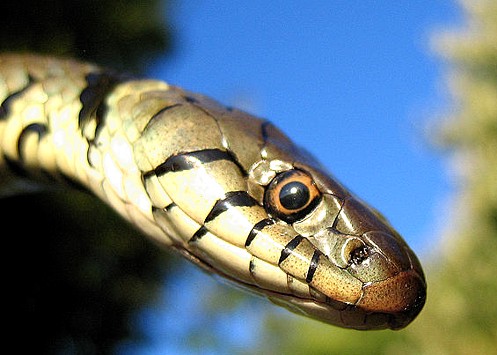
La biscia dal collare o natrice dal collare (Natrix natrix Linnaeus, 1758) è un colubride europeo non velenoso. La biscia dal collare è tipicamente verde scura o marrone con un collare giallo caratteristico dietro alla testa a cui deve il nome di biscia dal collare. Il colore potrebbe andare inoltre dal grigio al nero. La parte inferiore è più chiara. In Gran Bretagna la biscia dal collare è il rettile più grande e raggiunge una lunghezza totale di 120 cm.
Preda quasi interamente anfibi, specialmente le rane comuni, anche se occasionalmente mangia anche mammiferi e pesci. Le bisce dal collare sono grandi nuotatrici e di solito si trovano vicino agli specchi d'acqua dolce. Vanno in letargo durante l'inverno e si accoppiano poco dopo il risveglio ad aprile o maggio. Le uova vengono deposte in gruppi di 8 - 40 in giugno e luglio e si schiudono dopo circa 10 settimane. Poiché le uova richiedono una temperatura di almeno 21 gradi per schiudersi, la vegetazione in putrefazione, incluso i cumuli di composta (concime misto preparato con terra e sostanze fertilizzanti - per esempio letame - detto anche terricciato), sono postazioni preferite. I giovani sono lunghi circa 18 cm quando le uova si schiudono e sono da subito indipendenti. Poiché non sono velenosi, le loro uniche difese sono la produzione un fluido dall'odore aspro dalle ghiandole anali o la finzione della morte. A volte fingono anche degli attacchi, colpendo senza veramente aprire le loro bocche. Si difendono raramente mordendo.
Questo colubride si trova nei bassipiani dell'Inghilterra, del Galles, è quasi assente in Scozia e lo è del tutto in Irlanda. È ampiamente distribuito nell'Europa continentale, dalla Scandinavia settentrionale all'Italia meridionale. Si trova anche nell'Africa nord-occidentale, in Asia Minore e più a est fino al lago Baikal. In Italia è presente in tutta la penisola, Sicilia e Sardegna.
La specie comprende numerose sottospecie, ma non tutti gli esperti concordano sul loro numero. In Italia sarebbero presenti: Natrix natrix cetti in Abruzzo e in Sardegna; Natrix natrix helvetica nell'Italia centrosettentrionale con esclusione della porzione nordorientale; Natrix natrix natrix nel Friuli Venezia-Giulia e nella Pianura Padana orientale; Natrix natrix sicula endemica della Sicilia e Natrix natrix calabra endemica della Calabria.

The Grass Snake (Natrix natrix), sometimes called the Ringed Snake or Water Snake is an European non-venomous snake. It is often found near water and feeds almost exclusively on amphibians. The Grass Snake is typically dark green or brown in colour with a characteristic yellow collar behind the head, which explains the alternative name Ringed Snake. The colour may also range from grey to black, with darker colours being more prevalent in colder regions, presumably owing to the thermal benefits of being dark in colour. The underside is white with random blocks of black useful in recognizing individuals. In Great Britain the Grass Snake is the largest reptile reaching up to 190 centimetres total length, though such large specimens are rare. Females are considerably larger than males, typically reaching a size of 90-110 cm when fully grown. Males are approximately 20 cm shorter and significantly smaller in girth. Weighs 8 ounces.
This snake is distributed throughout lowland areas of England and Wales but is almost absent from Scotland and not found in Ireland, which has no resident snakes. It is widely distributed in continental Europe, ranging from mid Scandinavia to southern Italy. It is also found in north-western Africa. British Grass Snakes belong to the subspecies Natrix natrix. helvetica, but experts differ on the number of subspecies.
They prey almost entirely on amphibians, especially the common toad and the common frog, although they may also occasionally eat mammals and fish. Captive snakes have been observed taking earthworms offered by hand, but dead prey items were never taken. The bite is not dangerous as there are no teeth in the jaws. Just before the throat however there are teeth that can inject poisonous saliva in a prey prior to being swallowed. The snake can not use these teeth for biting. The snake will search actively for prey often on the edges of water using sight and sense of smell with Jacobsons organ. They consume the prey live without using physical constriction.
Grass Snakes are strong swimmers and may be found close to fresh water, although there is evidence that individual snakes often do not make use of water bodies throughout the entire season. The preferred habitat appears to be open woodland and 'edge' habitat such as field margins and woodland borders as these may offer adequate refuge while still affording ample opportunity for basking activity and thermoregulation. Pond edges are also favoured and the relatively high chance of observing this secretive species in such areas may account for their perceived association with ponds and water. Grass Snakes, as with most reptiles, are at the mercy of the thermal environment and need to overwinter in areas which are not subject to freezing. Thus they typically spend the winter underground where the temperature is relatively stable.
As spring approaches, the males emerge first and spend much of the day basking in an effort to raise body temperature and thereby metabolism. This may be a tactic to maximise sperm production as the males mate with the females as soon as they emerge up to 2 weeks later in April or earlier if environmental temperatures are favourable. The leathery skinned eggs are laid in batches of 8–40 in June to July and hatch after about 10 weeks. As eggs require a temperature of at least 21° C, but preferrably 28 °C and high humidity to survive and hatch, rotting vegetation, including compost heaps, are preferred locations. The young are about 18cm long when they hatch and are immediately independent.
After breeding in spring, snakes tend to hunt and may range widely during this time, moving several hundred metres in a day. Prey items tend to be large compared to the size of the snake and this impairs the movement ability of the snake. Snakes which have recently eaten rarely move any significant distance and will stay in one location, basking to optimize their body temperature until the prey item has been digested. Individual snakes may only need 2-3 significant prey items throughout an entire season.
Ecdysis also impacts upon the movement of grass snakes at least once during the active season. As the outer skin wears and the snake grows, the skin loosens from the body, including from the eyes, which may turn a milky white colour at this time. This presumably impacts upon the eyesight of the snake and they do not move or hunt during this time. The outer skin is eventually sloughed in one piece and normal movement activity is resumed.
Not
being venomous, the snake's only defence is to produce a foul-smelling fluid (containing
asafoetida) from the anal glands and/or feigning death by becoming completely
limp. Rarely, they may also perform fake attacks, striking without actually
opening their mouths. They bite in defense rarely. The species has various
predator species, including corvids, storks, owls and perhaps other birds of
prey, foxes and the domestic cat. In England, grass snakes are protected under
the Wildlife and Countryside Act 1981 and cannot be harmed or traded without
permission, although they may legally be captured and kept in captivity.
Two of the subspecies are considered critically endangered: N. n. cetti
(Sardinian Grass Snake) and N. n. schweizeri. In 2007, the Grass Snake
was included on the updated UK Biodiversity Action Plan as a species in need
of conservation and greater protection.
Natrix natrix persa
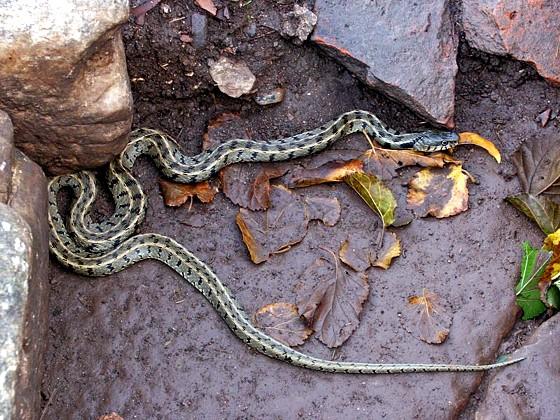
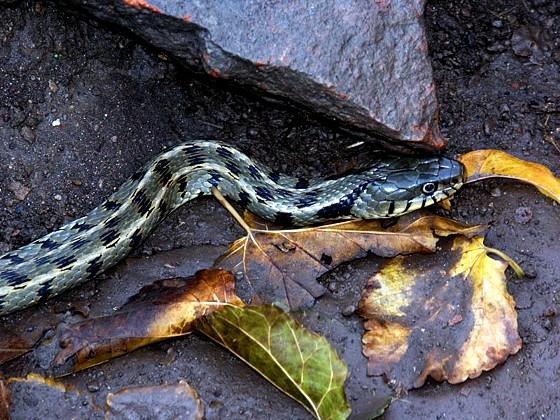
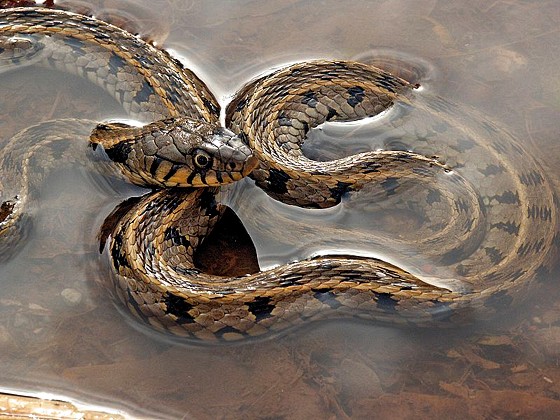
La couleuvre à collier (Natrix natrix) est un serpent de la famille des Colubridés. Elle est de couleur verte foncée prononcée ou brune avec un collier typique jaune ou blanc derrière la tête, auquel elle doit son nom. La couleur peut varier du gris au noir. La partie inférieure a une couleur plus claire, souvent blanche en damier noir. En Grande Bretagne, la couleuvre à collier est le reptile le plus grand et atteint une longueur totale de 120 cm. Elle se nourrit presque exclusivement d'amphibiens et apprécie particulièrement les grenouilles, bien qu'elle puisse parfois se nourrir de mammifères et de poissons. Les couleuvres à collier savent très bien nager et on peut les voir près des étendues d'eau.
Les couleuvres à collier hibernent durant l'hiver et s'accouplent peu après leur réveil en avril ou en mai. Les œufs sont pondus en groupes de 8-40 en juin-juillet et éclosent après 10 semaines d'incubation. Ils demandent une température d'au moins 21 degrés pour éclore: la végétation en putréfaction (tels les tas de compost) fait partie de leurs lieux de ponte préférés. À l'éclosion, les jeunes ont une longueur de presque 18 cm et sont tout de suite indépendants. N'étant pas venimeuse, les comportements de défense de cette couleuvre sont la sécrétion par les glandes anales d'un liquide à forte odeur ou encore la feinte de la mort. Elle peut parfois siffler fortement, simuler une attaque en frappant sans ouvrir vraiment la gueule. Il est extrêmement rare qu'elle se défende en mordant.
Ce serpent se trouve dans les plateaux de l'Angleterre, du Pays de Galles. Elle est totalement absente en Écosse. Elle est répandue en Europe continentale, de la Scandinavie du Nord à l'Italie méridionale. On la trouve même en Afrique nord-occidentale. Les couleuvres à collier anglaises appartiennent à la sous-espèce Natrix natrix helvetica, mais les experts discutent maintenant le nombre des sous-espèces.